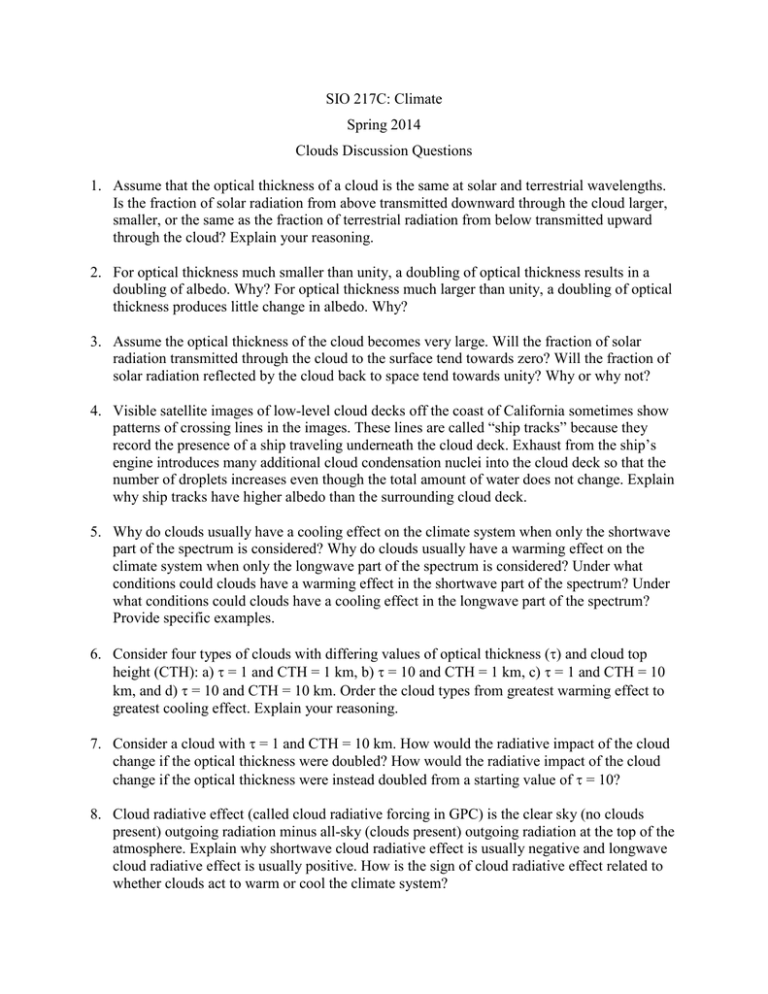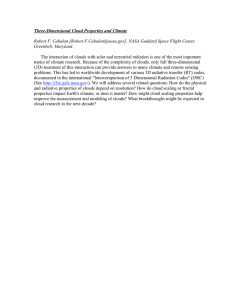SIO 217C: Climate Spring 2014 Clouds Discussion Questions
advertisement

SIO 217C: Climate Spring 2014 Clouds Discussion Questions 1. Assume that the optical thickness of a cloud is the same at solar and terrestrial wavelengths. Is the fraction of solar radiation from above transmitted downward through the cloud larger, smaller, or the same as the fraction of terrestrial radiation from below transmitted upward through the cloud? Explain your reasoning. 2. For optical thickness much smaller than unity, a doubling of optical thickness results in a doubling of albedo. Why? For optical thickness much larger than unity, a doubling of optical thickness produces little change in albedo. Why? 3. Assume the optical thickness of the cloud becomes very large. Will the fraction of solar radiation transmitted through the cloud to the surface tend towards zero? Will the fraction of solar radiation reflected by the cloud back to space tend towards unity? Why or why not? 4. Visible satellite images of low-level cloud decks off the coast of California sometimes show patterns of crossing lines in the images. These lines are called “ship tracks” because they record the presence of a ship traveling underneath the cloud deck. Exhaust from the ship’s engine introduces many additional cloud condensation nuclei into the cloud deck so that the number of droplets increases even though the total amount of water does not change. Explain why ship tracks have higher albedo than the surrounding cloud deck. 5. Why do clouds usually have a cooling effect on the climate system when only the shortwave part of the spectrum is considered? Why do clouds usually have a warming effect on the climate system when only the longwave part of the spectrum is considered? Under what conditions could clouds have a warming effect in the shortwave part of the spectrum? Under what conditions could clouds have a cooling effect in the longwave part of the spectrum? Provide specific examples. 6. Consider four types of clouds with differing values of optical thickness (τ) and cloud top height (CTH): a) τ = 1 and CTH = 1 km, b) τ = 10 and CTH = 1 km, c) τ = 1 and CTH = 10 km, and d) τ = 10 and CTH = 10 km. Order the cloud types from greatest warming effect to greatest cooling effect. Explain your reasoning. 7. Consider a cloud with τ = 1 and CTH = 10 km. How would the radiative impact of the cloud change if the optical thickness were doubled? How would the radiative impact of the cloud change if the optical thickness were instead doubled from a starting value of τ = 10? 8. Cloud radiative effect (called cloud radiative forcing in GPC) is the clear sky (no clouds present) outgoing radiation minus all-sky (clouds present) outgoing radiation at the top of the atmosphere. Explain why shortwave cloud radiative effect is usually negative and longwave cloud radiative effect is usually positive. How is the sign of cloud radiative effect related to whether clouds act to warm or cool the climate system? 9. What changes in cloud properties (optical thickness, top height, and horizontal extent) will cause shortwave cloud radiative effect to become more negative? What changes in cloud properties will cause longwave cloud radiative effect to become more positive? 10. It is possible for shortwave cloud radiative effect or longwave cloud radiative effect to change even without any change in clouds. Provide examples for how this could happen. Difficult Question 11. The ocean provides an essentially infinite reservoir of water to the atmosphere. Why is the Earth not completely cloud-covered as is Venus?


